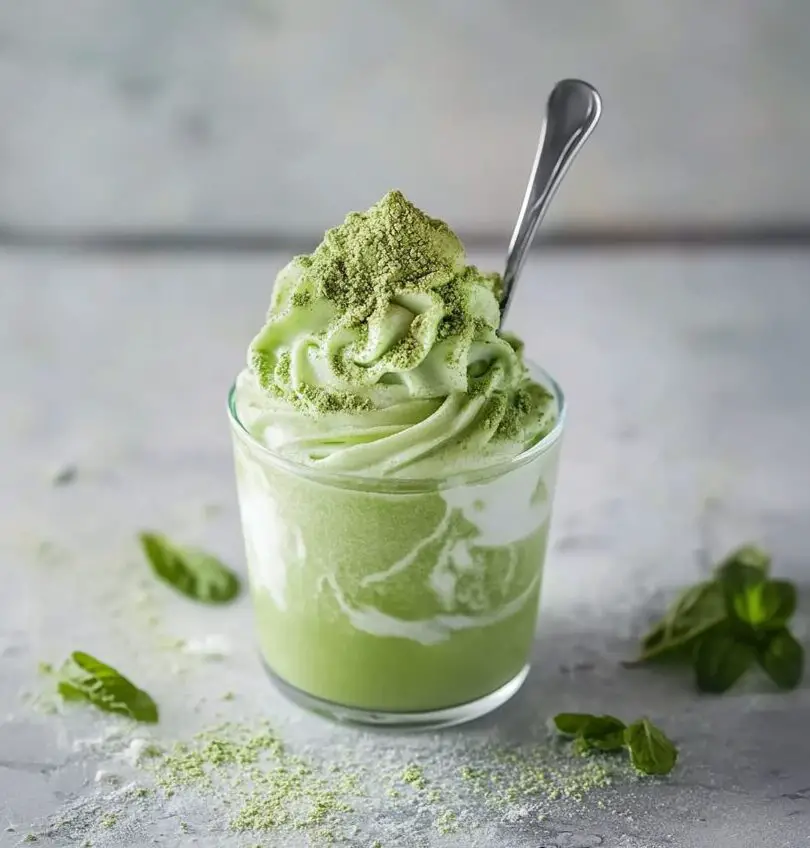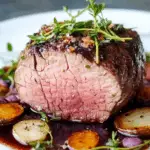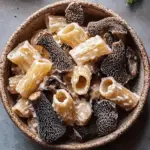Matcha Dalgona is a delightful twist on the viral dalgona coffee trend, offering a creamy, frothy beverage that combines the earthy flavors of matcha with the lightness of whipped topping. Perfect for those who prefer tea over coffee, this drink is both visually appealing and delicious. Whether you’re looking for a refreshing afternoon pick-me-up or a unique beverage to impress guests, Matcha Dalgona fits the bill.
Full Recipe:
Ingredients
- 1 large egg white (for a vegan alternative, use aquafaba or the thick coconut cream from a refrigerated can of coconut milk)
- 1 tablespoon sweetener of choice (e.g., granulated sugar, stevia, or monk fruit)
- 1 teaspoon matcha powder
- 1 cup milk of choice (e.g., coconut milk, hemp milk, or nut milk)
Directions
- In a small mixing bowl, use a hand beater to whip the egg white until frothy and almost stiff.
- Add in the sweetener, then continue beating until stiff peaks have formed.
- Sift the matcha powder into the egg white mixture. Use a whisk to thoroughly combine.
- Fill a glass with your chosen milk.
- Top the milk with the whipped matcha mixture using a spatula.
- Serve immediately and enjoy!
Nutrients
Note: Nutritional values may vary based on the specific ingredients used.
- Calories: Approximately 65 kcal
- Fat: 1g
- Carbohydrates: 13g
- Fiber: 1g
- Protein: 2g
- Sodium: 5mg
The Popularity of Dalgona Drinks
Dalgona coffee first became a global sensation during the pandemic when people were stuck at home and looking for something new to try. It began as a creative and easy-to-make coffee drink involving instant coffee, sugar, and milk. The whipped, foamy top layer of the drink was an appealing feature, leading many to share their attempts on social media platforms like TikTok and Instagram. As the trend continued to spread, many people began experimenting with the Dalgona concept, substituting the coffee with other ingredients to create variations of the original recipe. This paved the way for a non-coffee version — the Matcha Dalgona.
What sets Matcha Dalgona apart from its coffee counterpart is the distinct flavor profile of matcha. While coffee Dalgona offers a deep, slightly bitter taste, matcha Dalgona delivers a softer, more subtle flavor with grassy and slightly sweet notes. For many, matcha’s unique taste and smooth texture make it an appealing alternative to coffee, especially for those who prefer tea-based beverages.
What is Matcha?
Matcha is a finely ground powder made from green tea leaves. Unlike traditional tea where the leaves are steeped in water and then discarded, matcha involves consuming the entire tea leaf in powdered form, making it more concentrated and beneficial. Originating from Japan, matcha has been a central part of Japanese tea ceremonies for centuries, celebrated not only for its delicate flavor but also for its numerous health benefits.
The process of making matcha involves shading the tea plants before harvesting, which increases the chlorophyll content and enhances the flavor. After harvesting, the leaves are steamed to preserve their color and nutrients, then dried and ground into a fine powder. This unique process ensures that matcha retains more antioxidants, vitamins, and minerals compared to traditional green tea.
Matcha is widely regarded for its health benefits, particularly its high levels of antioxidants, which are thought to help reduce inflammation and improve overall health. Additionally, it contains L-theanine, an amino acid that promotes relaxation and reduces stress, creating a calming effect when consumed.
Health Benefits of Matcha
One of the most attractive aspects of drinking matcha is its impressive health benefits. Matcha is packed with antioxidants, including catechins, which are believed to fight free radicals in the body, helping to reduce oxidative stress. These antioxidants are essential in supporting overall well-being by protecting cells from damage and potentially reducing the risk of chronic diseases like heart disease and cancer.
Matcha is also known for its ability to provide a sustained energy boost. Unlike coffee, which can cause a quick spike in energy followed by a crash, matcha offers a more balanced and longer-lasting energy release. This is largely due to the combination of caffeine and L-theanine, which work together to promote focus and mental clarity without the jitteriness often associated with coffee.
In addition to being an excellent source of antioxidants and providing a steady energy boost, matcha has been linked to weight management. Some studies suggest that the catechins in matcha can help increase metabolism and fat oxidation, which may support weight loss efforts when combined with a healthy diet and exercise routine.
The Role of Dalgona in the Recipe
Dalgona, the whipped element of this recipe, is named after a popular Korean candy that is light, airy, and crisp. The candy itself is made by melting sugar and baking soda, which creates a bubbly, golden structure. The whipped topping that became synonymous with Dalgona coffee mimics the texture and visual appeal of the candy, hence the name.
In the case of Matcha Dalgona, the whipped mixture is created using matcha powder, sweeteners, and egg whites (or a vegan substitute like aquafaba). Whipping the ingredients together results in a light, fluffy foam that contrasts beautifully with the smooth, creamy milk base. This combination of textures is part of what makes Dalgona-style drinks so popular — the smoothness of the liquid and the fluffy foam create an indulgent sensory experience.
The whipped matcha topping not only adds to the aesthetic appeal of the drink but also enhances the overall flavor. The slight bitterness of the matcha powder in the foam perfectly balances the sweetness of the milk, creating a harmonious, layered taste.
Customization Options
One of the best things about the Matcha Dalgona recipe is its versatility. There are several ways to customize the drink to suit different tastes and dietary preferences.
For instance, you can adjust the sweetness level by choosing a sweetener that fits your preferences. Whether you opt for granulated sugar, honey, agave, or a sugar-free option like stevia or monk fruit, you can control how sweet the drink becomes.
Another option for customization is the type of milk you use. Traditional dairy milk works well in this recipe, but it’s also easy to make the drink dairy-free by opting for plant-based milk such as almond milk, oat milk, or coconut milk. These alternatives can also change the flavor profile of the drink, giving it an additional layer of taste. For instance, coconut milk can add a tropical, creamy sweetness, while oat milk lends a more neutral and rich flavor.
For those who prefer a more intense matcha flavor, the amount of matcha powder can be adjusted according to personal taste. Some may prefer a stronger matcha flavor, while others might opt for a more subtle version. Adjusting the matcha-to-sweetener ratio allows you to create a more tailored experience.
Serving Suggestions
Matcha Dalgona is best served as a refreshing, standalone beverage, but it can also be paired with a variety of foods. It makes a wonderful accompaniment to breakfast or brunch dishes, such as avocado toast, pancakes, or muffins. Its balance of caffeine and antioxidants makes it a suitable drink for starting the day or enjoying as an afternoon pick-me-up.
Conclusion
Matcha Dalgona is not just a beverage; it’s an experience. From the vibrant green color to the frothy, creamy texture, every sip is a treat for the senses. It offers a modern twist on the beloved Dalgona trend, combining the power of matcha with the lightness of whipped foam to create a refreshing and energizing drink. Packed with antioxidants, providing a balanced energy boost, and offering endless customization options, it’s a drink that can be enjoyed by anyone, regardless of dietary preferences or caffeine tolerance.






